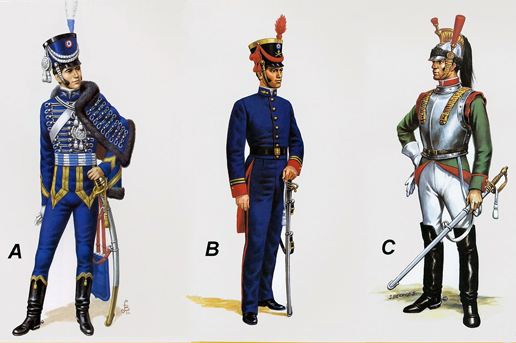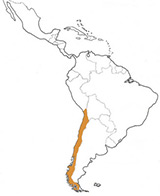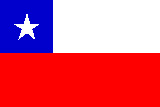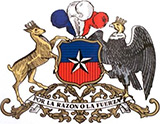Depuis l’origine, la mode militaire chilienne refléta celle de l’Europe et, tout particulièrement celle des pays ou régnaient des Bourbon. Les uniformes et coiffures influencés par l’Espagne, le Portugal et ensuite la France, étaient toutefois généralement simplifiés, au vu du contexte climatique et de pauvreté régnant en Amérique latine. Les unités créoles qui, au XVIIIème siècle affrontèrent les indiens Mapuches, développèrent notamment un style particulier.La France comme modèleL’armée chilienne vit le jour le 2 décembre 1810, comme continuatrice de l’armée de la Capitainerie Générale du Chili. Au début du XIXème siècle, le prestige des armes napoléoniennes conduit à l’adoption d’uniformes “à la française” comme on peut le voir sur l’illustration ci-dessous.
L’ordonnance du 29 avril 1852 (en vigueur jusqu’en 1878) introduit le large pantalon rouge, le dolman et le képi, à la mode du Second empire français.
Durant la Guerre du Pacifique, (1879-1884), les uniformes se simplifièrent et un casque de liège fut introduit pour les officiers.
L’ordonnance du 29 avril 1852 (en vigueur jusqu’en 1878) introduit le large pantalon rouge, le dolman et le képi, à la mode du Second empire français.
Durant la Guerre du Pacifique, (1879-1884), les uniformes se simplifièrent et un casque de liège fut introduit pour les officiers.

A: Officier, Régiment de Hussar de la Grande Garde, ca. 1812; B: Officier, Artillerie à pied, 1827; C: Troupe, Escadron de Cuirassiers, 1827 (dessin J. Berrios S.)
CHILE
Officially, Chile gained its independence in 1818 after the defeat of the royalist forces at the battle of Chacabuco, but by 1810 a Chilean army had already been formed. From its origin until 1890, the French influence was dominant and French cuirassier-type helmets were widely worn. Following the Chilean victory in the Pacific War in 1884, French influence in army procurement faded, replaced by German military doctrine and equipment.
In 1898 the Pickelhaube was introduced into the Chilean armed forces, but in 1879 some helmets had already been used, captured from Peru. This type of helmet is still in use today for ceremonial occasions, and since 2006 they have been manufactured locally or acquired from European suppliers.
From 1879 until the 1950s a cork helmet of German manufacture, covered with gray-green fabric, was worn.
At the end of the 1930s, the decision was made to issue a steel helmet, and a number of Czechoslovakian Vz-32 helmets were imported. These helmets were painted gray, and a badge with the national colors was added on the side. Despite the criticism of this helmet (balance problems), they remained in service until the 1970s.
Impressed by the German military “style,” Santiago imported a large quantity of light Vulkanfiber M1933 from Berlin in the 1930s. Like the Vz-32, this headgear was to remain in use until the 1970s.
Beginning in the 1970s, locally made lightweight copies of the German Stahlhelm M35 were manufactured locally under the identification Casco Modelo Alemán Gris-Verde.
After the signature of the Inter-American Treaty of Reciprocal Assistance (Rio Treaty) in 1947 by Chile, the impact of American military influence began to be felt. One consequence of this new friend in North America was the introduction of the US M1 helmet at the end of the 1940s.
During the 1970s, fearing an international threat, Chile purchased a large quantity of Brazilian and European M1 clones. Simultaneously, the Israeli OR-201/M76 was issued to paratroops, and a South Korean fiber helmet, the Daewoo M76, was introduced. In 1983, the locally made M1/83 was first put into service.
The current Chilean army is characterized by two uniform styles. German-style gray uniforms are worn for ceremonies and full-dress events, and for combat operations the NATO-style is now the standard -issue.
In the 1990s metal M35 German-style helmets were manufactured locally in Famae but were only used experimentally or for ceremonial events.
At the beginning of the twenty-first century, Chilean-made PASGT clones called Modelo Golfo began replacing the aging US M1. However, the standard helmet of the current Chilean Army is the Israeli helmet RBH-303 Golfo.
Specialized units use a variety of helmets from several sources, including models produced locally and issued to combat engineers for de-mining operations.
Armored unit crews have traditionaly worn American headgear imported with the vehicles (currently the CVC DH-132A), although crews of some German-made tanks wear German Lederhelme.
Officially, Chile gained its independence in 1818 after the defeat of the royalist forces at the battle of Chacabuco, but by 1810 a Chilean army had already been formed. From its origin until 1890, the French influence was dominant and French cuirassier-type helmets were widely worn. Following the Chilean victory in the Pacific War in 1884, French influence in army procurement faded, replaced by German military doctrine and equipment.
In 1898 the Pickelhaube was introduced into the Chilean armed forces, but in 1879 some helmets had already been used, captured from Peru. This type of helmet is still in use today for ceremonial occasions, and since 2006 they have been manufactured locally or acquired from European suppliers.
From 1879 until the 1950s a cork helmet of German manufacture, covered with gray-green fabric, was worn.
At the end of the 1930s, the decision was made to issue a steel helmet, and a number of Czechoslovakian Vz-32 helmets were imported. These helmets were painted gray, and a badge with the national colors was added on the side. Despite the criticism of this helmet (balance problems), they remained in service until the 1970s.
Impressed by the German military “style,” Santiago imported a large quantity of light Vulkanfiber M1933 from Berlin in the 1930s. Like the Vz-32, this headgear was to remain in use until the 1970s.
Beginning in the 1970s, locally made lightweight copies of the German Stahlhelm M35 were manufactured locally under the identification Casco Modelo Alemán Gris-Verde.
After the signature of the Inter-American Treaty of Reciprocal Assistance (Rio Treaty) in 1947 by Chile, the impact of American military influence began to be felt. One consequence of this new friend in North America was the introduction of the US M1 helmet at the end of the 1940s.
During the 1970s, fearing an international threat, Chile purchased a large quantity of Brazilian and European M1 clones. Simultaneously, the Israeli OR-201/M76 was issued to paratroops, and a South Korean fiber helmet, the Daewoo M76, was introduced. In 1983, the locally made M1/83 was first put into service.
The current Chilean army is characterized by two uniform styles. German-style gray uniforms are worn for ceremonies and full-dress events, and for combat operations the NATO-style is now the standard -issue.
In the 1990s metal M35 German-style helmets were manufactured locally in Famae but were only used experimentally or for ceremonial events.
At the beginning of the twenty-first century, Chilean-made PASGT clones called Modelo Golfo began replacing the aging US M1. However, the standard helmet of the current Chilean Army is the Israeli helmet RBH-303 Golfo.
Specialized units use a variety of helmets from several sources, including models produced locally and issued to combat engineers for de-mining operations.
Armored unit crews have traditionaly worn American headgear imported with the vehicles (currently the CVC DH-132A), although crews of some German-made tanks wear German Lederhelme.



